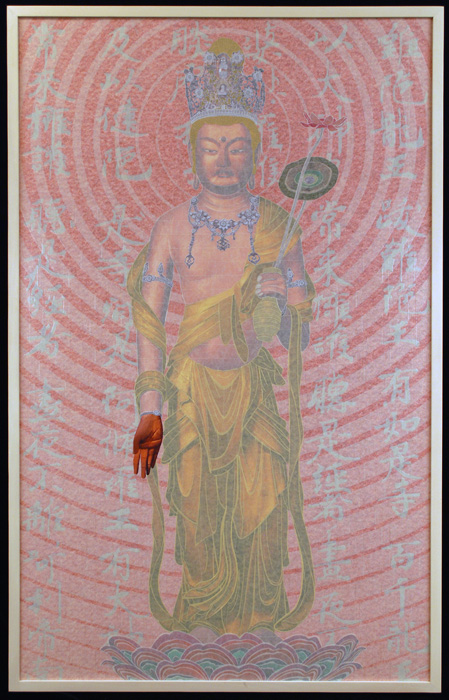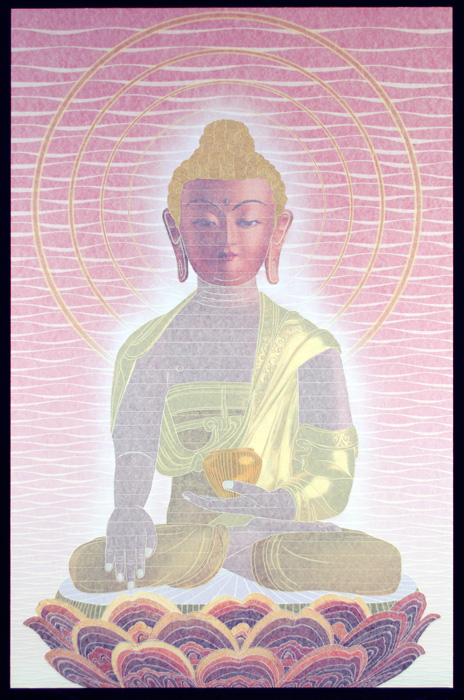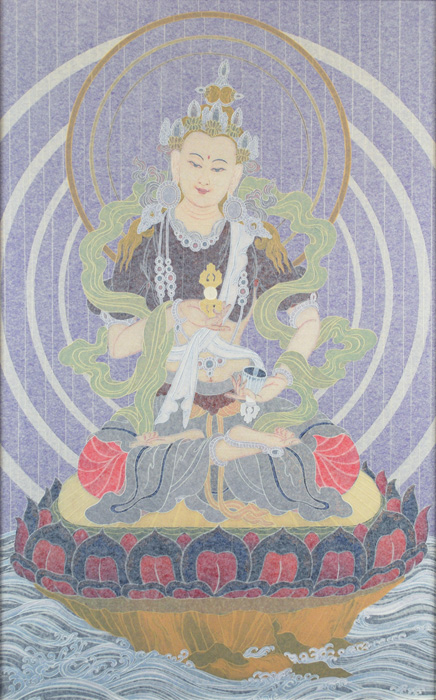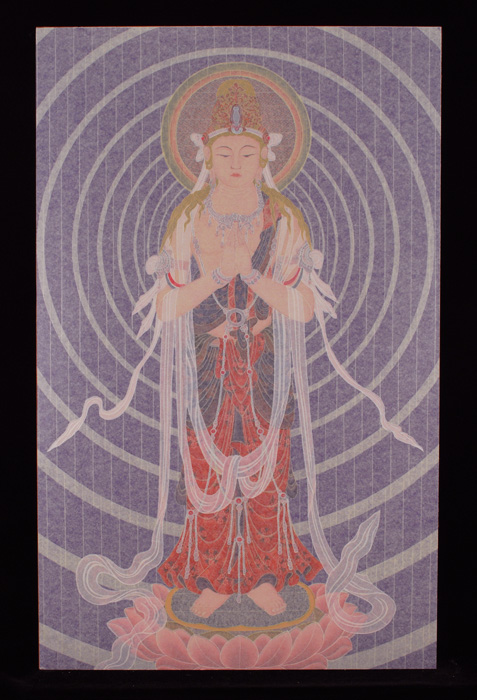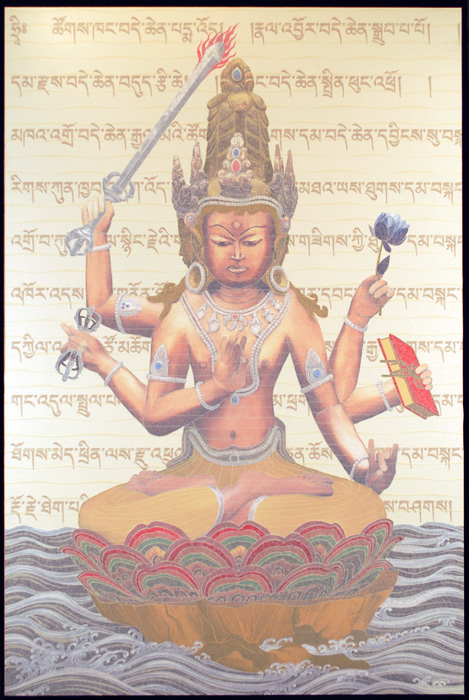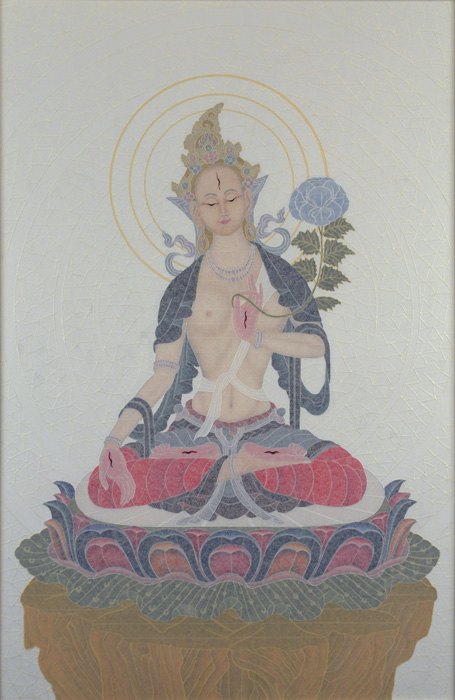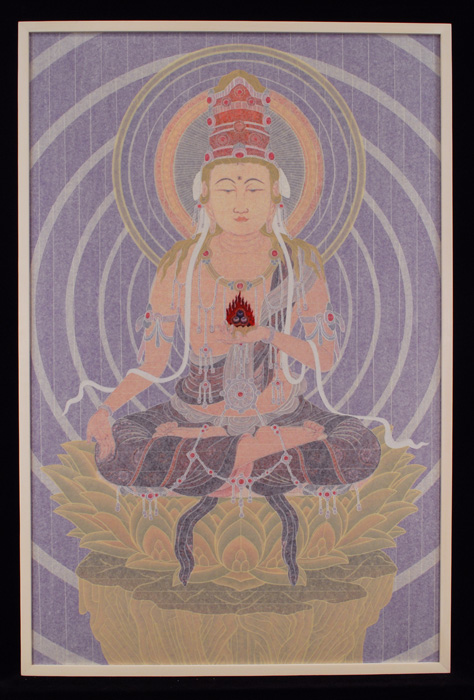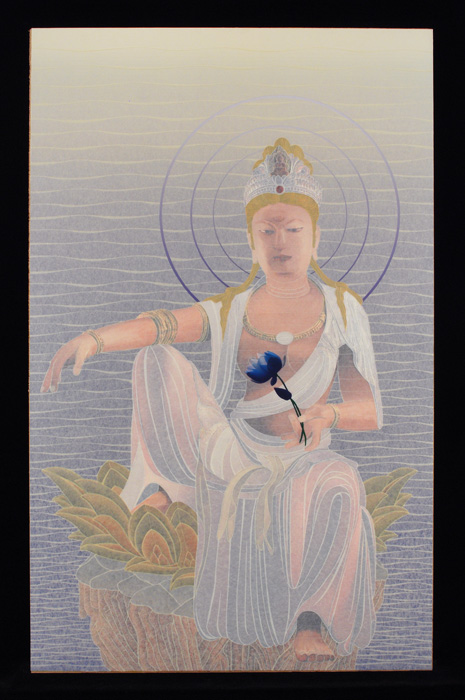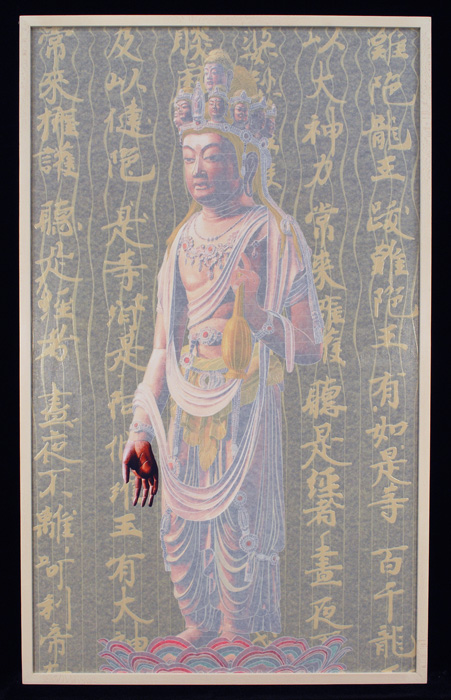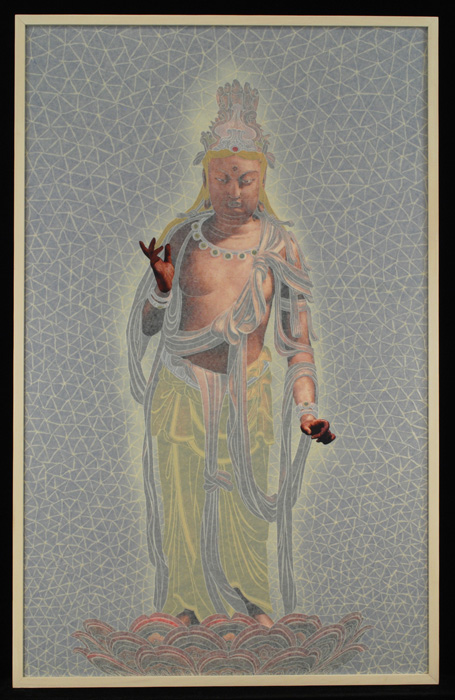Patrick Nagatani: Tape/estries: The Spirit of Permanence and Impermanence
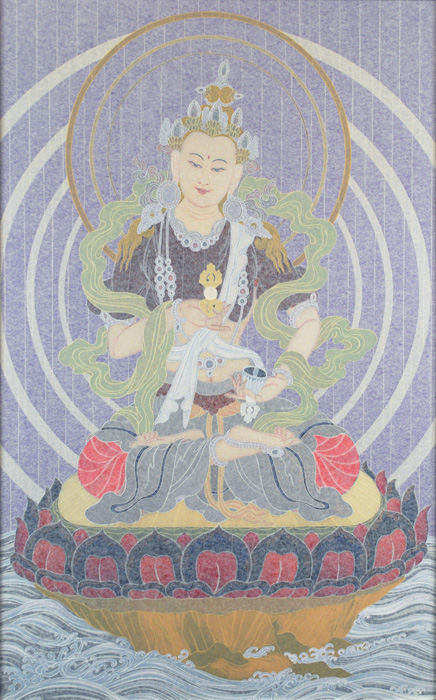
“Vajrapani, 2010 – He is one of the earliest bodhisattvas of Mahayana Buddhism and one of three protective deities surrounding the Buddha. He is the “Holder of the Thunderbolt Scepter” symbolizing the power of compassion. He represents intense determination and success in the conquest of negativity.
Patrick Ryoichi Nagatani‘s amazing work, “Tape/estries”, is currently on exhibition at the Center of Fine Art Photography through July 19th. He brings to the walls an unusual, methodical approach of transforming photographs into art. Using “chromogenic lightjet photographs from a variety of sources that are often collaged and manipulated in Photoshop” he tapes over the images with ordinary masking tape, creating a dimensional and muted surface. His process truly brings all arenas of art making into play and the work is a nod to so many painters and sculptors who have been influenced by the photograph.
Patrick earned his M.F.A. from the University of California, Los Angeles in 1980. Nagatani has given numerous public lectures, seminars and workshops and his work has been exhibited widely both nationally and internationally.
Some of his awards include: The Aaron Siskind Foundation Individual Photographer’s Fellowship, The Kraszna-Krausz Award for his book Nuclear Enchantment, the Leopold Godowsky Jr. Color Photography Award, the Eliot Porter Fellowship in New Mexico, and the California Distinguished Artist Award from the National Art Education Association. He has served as a panelist for the Illinois Art Council, Southern Arts Federation, Massachusetts Council on the Arts and Humanities, Mid-Atlantic Arts Foundation, California Arts Council, and the National Endowment for the Arts. He is an honored recipient of the “Governor’s Award for Excellence in the Arts” from Governor Bill Richardson in New Mexico as well as the Honored Educator Award from the Society of Photographic Education in 2008.
His survey show and book, Desire for Magic – Patrick Nagatani 1978-2008, premiered at the University of New Mexico traveled to the Japanese American National Museum in L.A. and was exhibited at the Clay Center for the Arts and Sciences of West Virginia. He retired as a Professor from the Department of Art and Art History at UNM in 2006 after teaching art / photography there for 20 years.
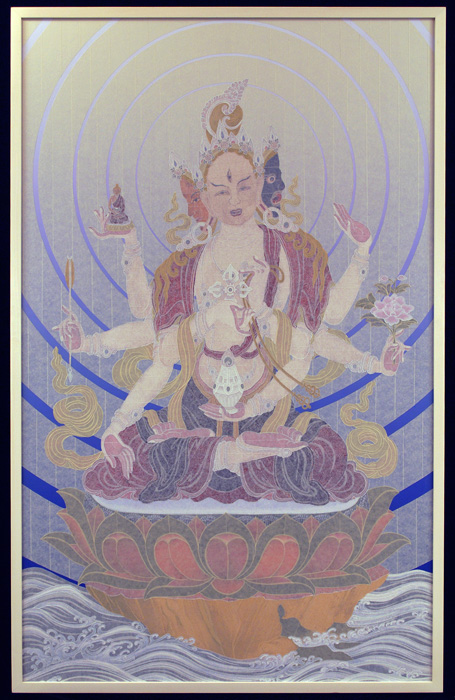
“Ushnishavijaya,” 2010 – Or “Victorious Crown of Protrusion,” is an emanation of the archetypal goddess, Prajnaparamita.” She is the Prajna, or female aspect of enlightenment and representative of the void or shunyata. A well known goddess in Tibet, Nepal and Mongolia, she is the Buddha of long life. Nagatani’s image shows her with three faces and eight hands seated on a floating lotus in choppy seas. Among other objects, she holds a vial of water used for cleansing one of disease.
TAPE-ESTRIES: The Spirit of Permanence and Impermanence
The process is like driving from Albuquerque to Los Angeles non-stop. It’s like being in shape and running ten miles. It’s like chanting. It’s like doing all the movements of Tai Chi the meditative way. It’s about finding a zone of no thought. Time passes and only my aching fingers and shoulders indicate how long I have been continuously painting with the tape. I relish the focus on details and to be lost in the quiet and minute parts of the whole. Decisions are mostly made as a reaction to the materials, the image and the emotive feel. Time is a factor. It must take long sessions to get to the zone. After each session there is another zonal journey. Clarity often comes after a long session. More things are revealed to me after each session. Magic is a goal. My entire day is shaped by solitude and what I believe is constructed beauty. I want magic in my life and work. Beauty is important. I relish the fact that the tape is an inexpensive and somewhat castaway art material. The Zen of the material and process moves me to a spiritual happiness.
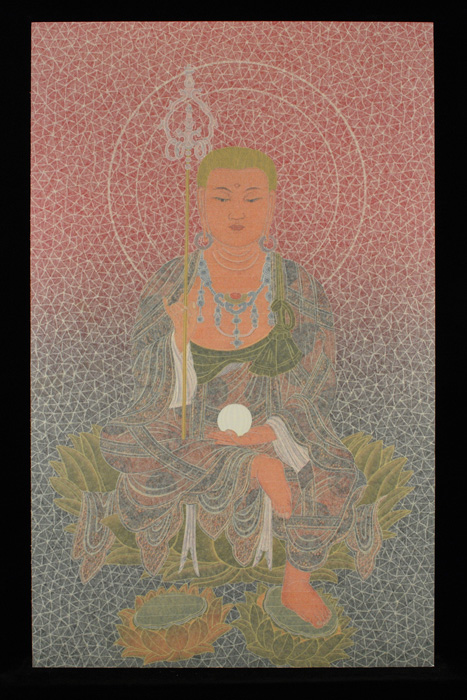
“Ksitigarbha,” 2009 – In this mosaic-like work, Nagatani created an vastly intricate texture with thin strips of tape. Ksitigarbha is a Buddhist monk who made a vow not to achieve Buddhahood until all hells are emptied. His staff forces open the gates of hell, thus he is a bodhisattva of beings in hell, as well as a guardian of children, including dead ones. His name translates as “Earth Treasury,” “Earth Store,” “Earth Matrix,” or “Earth Womb.”
I have often desired the overlay of sensory experience in my work. These pieces require looking from afar and getting in very close, both vantage points offer differing visual experience. The pieces are wonderful to touch. I’ve been in the zone off and on for over thirty years with this work. Time has no fixed position, it has been positive energy for me. It has left me no room or desire for negative creative existence. Most things seem to now have a place in the cosmic meaning of things. Especially in coping with getting older, dealing with cancer and losing both of my parents recently.
The taping process is obsessive. It is done with precision and ardor. Masking tape is a simple material. I use every variety of masking tape that is commonly available. The subtle color of the tape creates my range of hues for my “painting” palette. There are varying degrees of translucency and the amount of layers dictate a value shift. The tearing and cutting parodies a variety of “brush strokes.” The original surface images are large Chromogenic Lightjet photographs from a variety of sources that are often collaged and manipulated in Photoshop. These are cold mounted with Coda (two sided archival adhesive) to museum board. The archival museum board is contact cemented to oak wood laminate and stretcher bars are wood glued for stability. Finally, the entire finish taped surface is multi-coated with Golden Acrylic Matte Medium of different strengths. Two final brush coatings of Golden Polymer Varnish with UVLS (Ultraviolet filters and stabilizers) are finally applied. Although masking tape is not considered an “archival” medium, the matte medium both seals the piece from oxidation and soaks through the masking tape for added adhesion. My “tapist” career started in 1982 and the pieces made at that time have lasted throughout the years. I believe that the pieces have a life of their own and will change very slowly in time, much like mummies from ancient Egypt have lasted through the centuries but nevertheless have changed. The work might be seen as an evolving entity with the spirit of permanence and impermanence interwoven into the materials used in the artistic process.
Time passes and only my aching fingers and shoulders indicate how long I have been continuously painting with tape. Decisions are made as a reaction to the materials. My entire day is shaped by solitude and what I believe is constructed beauty. I relish the fact that the tape is an inexpensive and somewhat castaway art material. The Zen of the material and process moves me to spiritual happiness.
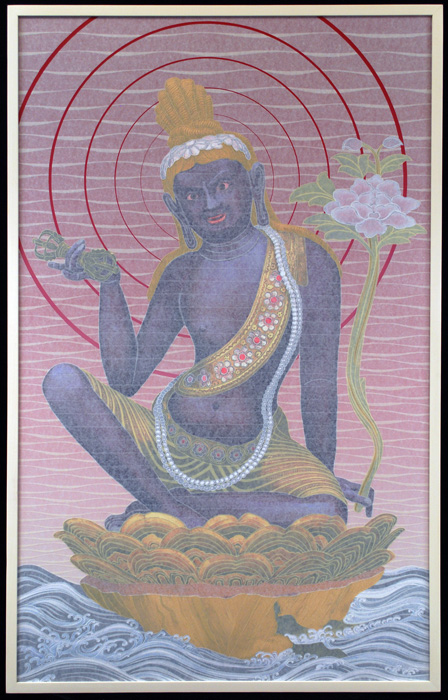
“Vajrapani, 2010 – He is one of the earliest bodhisattvas of Mahayana Buddhism and one of three protective deities surrounding the Buddha. He is the “Holder of the Thunderbolt Scepter” symbolizing the power of compassion. He represents intense determination and success in the conquest of negativity.
A perfect quote from Patricia J. Graham’s book, Faith and Power in Japanese Buddhist Art 1600-2005, regarding artists influenced by using Buddhist imagery in Japan, hits home to my thinking today. “All these artists turned to Buddhist imagery for intensely personal reasons, without regard for the whims of the art establishment, and developed distinctive styles for Buddhist subjects. They borrowed freely from Western art, philosophy and art materials in order to instill new life into traditional religious themes, and they completely absorb themselves into their work, which itself becomes a path of self-cultivation.”
Posts on Lenscratch may not be reproduced without the permission of the Lenscratch staff and the photographer.
Recommended
-
Luther Price: New Utopia and Light Fracture Presented by VSW PressApril 7th, 2024
-
Artists of Türkiye: Sirkhane DarkroomMarch 26th, 2024
-
European Week: Sayuri IchidaMarch 8th, 2024
-
European Week: Steffen DiemerMarch 6th, 2024
-
Rebecca Sexton Larson: The Reluctant CaregiverFebruary 26th, 2024

